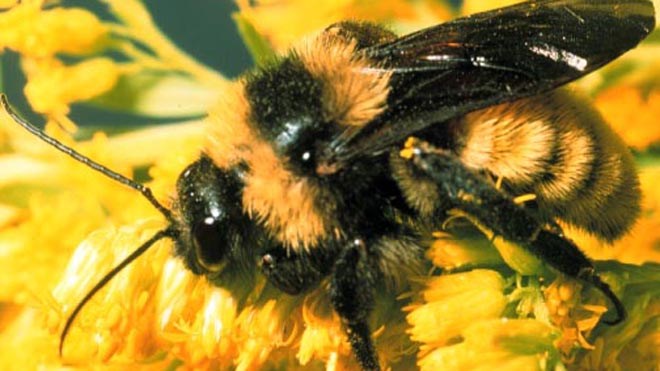This article, written by Sheila R. Colla, York University, Canada and Rachel Nalepa, York University, Canada, originally appeared on The Conversation and is republished here with permission:
A quintessential sign of spring is a busy bee happily buzzing from blossom to blossom. While spring is now in full swing across Canada, the presence of those dependable pollinators is becoming more and more uncertain.
Our research team is focused on assessing the status of wild pollinators, understanding the threats they face and working to conserve species at risk of extinction before it’s too late.
What we’ve learned about bee declines may surprise even the most avid nature lover.
Canada’s bee diversity
Pollinator declines have become one of the most talked about environmental issues. While media, policy and public discourse have focused on neonicotinoid pesticides and the loss of European honeybees, the story of bee decline is much more complex than that.
In Canada, we have more than 850 species of native bees, and the vast majority of those species have not been assessed to properly understand how they are faring in the wild. None of our native bees make honey. Most are solitary (that is they don’t live in hives), most live underground and many cannot sting.
They come in an array of colours including blue, metallic silver and green. Each of our native bee species has their own nesting and foraging needs. Some live in grasslands, others in forests. Some have adapted well to our urban, built environments. They each react to various threats differently.
A bee is not a bee is not a bee
While honeybees have their own management issues (including exposure to neonicotinoids in agricultural landscapes), we must understand that they are imported to North America for human benefit to produce honey and pollinate large farms. Some people keep honeybees as a hobby. They are not at risk of extinction and they can even negatively impact wild bee populations and plant communities.
The idea of promoting honeybees to conserve declining bees can be likened to throwing millions of Asian carp (an invasive species) into Lake Ontario to save native fishes — it’s a ludicrous proposition to conservationists. Instead, we must determine which wild bee species are in decline and what threats cause harm to their populations, and then design evidence-based conservation management plans to keep them from going extinct.
Recently, the Bumblebee Specialist Group for the International Union for the Conservation of Nature assessed the status of North America’s bumblebees (the best understood group of native bees). Startlingly, the group found one in four of our native bumblebees are at risk.
Some species, like the critically endangered rusty-patched bumblebee, have declined drastically over few decades. Growing evidence suggests habitat loss, climate change and disease spillover from managed bees are the top threats to bumblebees. Recently, our lab found the American bumblebee has declined by more than 85 per cent in recent decades throughout its Canadian range of southern Ontario and Québec. If we are to conserve this and other species, we need to act quickly.
Biodiversity for resilience and sustainability
Keeping sustainable populations of wild bees should matter to every one of us, not just nature enthusiasts. Study after study confirms that maintaining our pollinator biodiversity keeps our agricultural systems and natural ecosystems resilient. When parasites like Varroa mites hit managed honeybees, wild bees provide insurance, pollinating crops that otherwise may not produce food.
Wild bees pollinate our crops in rural areas, our residential vegetable gardens and even our rooftop gardens. These free pollination services translate directly into economic benefits for humans and contribute to local food security.
Wild bees also pollinate flowers, trees and shrubs, which in turn feed and shelter other native wildlife, provide flood control, prevent soil erosion and help regulate the climate.
Bees serve as an important example of how biodiversity provides free ecosystem services upon which humans and other wildlife rely. They are taken for granted, but if they disappear the consequences will be cascading and significant.
Recently, the United Nations prepared an extensive report synthesizing how biodiversity declines are leading to the loss of ecosystem services globally. Some governments, including in Ontario, have framed conservation as too costly an endeavour or as hindrance to development. This is short-sighted and does not consider the real costs of losing biodiversity.
We need transformational change for how we steward our private and public lands and how we value our natural ecosystems and wildlife. To better conserve our biodiversity, we need to create habitat big and small, whether in our city gardens or large protected areas.
We need to fund basic science to better understand ecosystem processes and species interactions in a changing world. We need to demand sound policy based on evidence and use the precautionary principle where knowledge gaps exist.
We need to include Indigenous knowledge systems and consider future generations in decision-making. We need adults and children alike to observe the natural world and learn the names of local species. Citizen science projects such as BumbleBeeWatch are great ways to learn while helping scientists gather information.
The solutions to “save the bees” and other native wildlife are complex and multi-faceted.
While out and about this spring, take a moment to notice that bumblebee sipping nectar from a flower. It is an interaction that is simple, but not inconsequential.
It offers us the opportunity to consider the intricate links between plants, humans, wildlife and the land that make our very way of life possible. It is up to us to do everything we can to ensure these connections remain strong not only for ourselves, but for future generations.![]()
Sheila R. Colla, Assistant Professor of Environmental Studies, York University, Canada and Rachel Nalepa, Post-Doctoral Fellow, York University, Canada
This article is republished from The Conversation under a Creative Commons license. Read the original article.



